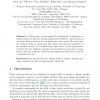600 search results - page 11 / 120 » The role of the striatum in adaptation learning: a computati... |
ICANN
2009
Springer
14 years 2 months ago
2009
Springer
Abstract. In this paper, we investigate the application of adaptive ensemble models of Extreme Learning Machines (ELMs) to the problem of one-step ahead prediction in (non)stationa...
CVPR
2007
IEEE
14 years 9 months ago
2007
IEEE
We present a hierarchical generative model for object recognition that is constructed by weakly-supervised learning. A key component is a novel, adaptive patch feature whose width...
FOCI
2007
IEEE
14 years 1 months ago
2007
IEEE
Recent progress in genomics and proteomics makes it possible to understand the biological networks at the systems level. We aim to develop computational models of learning and memo...
IUI
2006
ACM
14 years 1 months ago
2006
ACM
In this paper we describe research on using eye-tracking data for on-line assessment of user meta-cognitive behavior during the interaction with an intelligent learning environmen...
AAMAS
2002
Springer
13 years 7 months ago
2002
Springer
Abstract. How and where are the universal features of language specified? We consider language users as situated agents acting as conduits for the cultural transmission of language...

